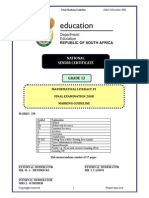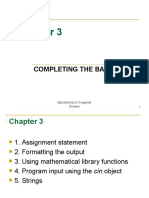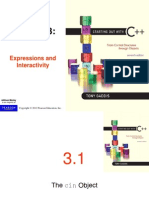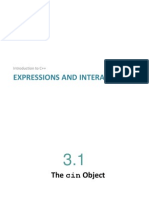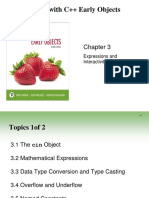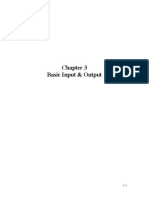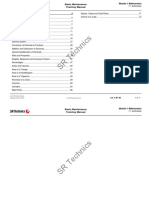Lab 4 Strings & Formatted Output: 4.1 Objectives
Uploaded by
hazyhazy9977Lab 4 Strings & Formatted Output: 4.1 Objectives
Uploaded by
hazyhazy9977LAB 4
STRINGS & FORMATTED OUTPUT
4.1 OBJECTIVES
- To practice arithmetic operators and expression evaluation
- To get familiar with strings and exercise its basic functions
- To know the usage of setw and setprecision manipulators
4.2 PRE-LAB READING
4.2.1 ARITHMETIC OPERATORS & EXPRESSION EVALUATION
The following are some arithmetic operators used to perform different operations on
variables/constants. Most of them are easy to understand and use.
Operator Symbol Operation
+ Addition
- Subtraction
* Multiplication
/ Division
% Modulus
Integer Division
When we divide two integers, of course the result of this division will be an integer. This is because the
decimal part is truncated or “chopped” from the number. Thus 9/5 will give the answer 1 not 1.8. For
this reason there are two division operations for integer numbers. The modulus operator, (%) used only
with integers, gives the remainder of a division operation.
Therefore, 9 / 5 gives 1 while 9 % 5 gives 4 (the remainder of the division).
Activity:
Observe the output of following:
int numerator=9, denominator=7, Q,R;
Q = numerator/denominator;
R = numerator% denominator;
cout<<”I am dividing ”<<numerator<<” by ”<<denominator<<endl<<endl;
cout<<”Quotient of division is: ”<<Q<<endl;
cout<<”Remainder of division is: ”<<R<<endl;
C++ EXPRESSIONS
We know that an assignment statement consists of two parts: a variable on the left and a value to be
assigned on the right. The right side may have an expression as well. An expression in C++ is a
combination of variables, constants and various operators. For example:
circumference = 2*PI*radius ;
diff = 105 - 78 ;
ans = 8 * 4/2 + 9 - 4/2 + 6 * (4+3);
Expressions are evaluated (i.e. simplified and converted to one value) and the result is placed in the
memory location corresponding to the variable on the left. Let’s consider the last expression. Can you
tell in which order it would be evaluated?
The answer depends on the precedence of the operators used in this expression.
Precedence of Arithmetic Operators
Parenthesis
High to low
Unary operators (e.g increment/decrement operator)
Multiplication, division, modulus
Addition, subtraction
4.2.2 STRING: ANOTHER DATA TYPE
As char is used to store any single character, similarly there is another data type used to store sequence
of characters. You can define variables that hold strings.
string name = "Harry";
The string type is a part of the C++ standard. To use it, simply include the header file, <string>:
#include <string>
Unlike number variables, string variables are guaranteed to be initialized even if you do not supply an
initial value. By default, a string variable is set to an empty string: a string containing no characters. An
empty string literal is written as "". Both the following statements have same effect.
string response;
string response = "";
CONCATENATION
The “+” operator is used to concatenate two strings. For example,
string fname = "Harry";
string lname = "Morgan";
string name = fname + lname;
results in the string
"HarryMorgan"
What if you’d like the first and last name separated by a space? No problem:
string name = fname + " " + lname;
Now the result is
"Harry Morgan"
STRING INPUT
You can read a string from the console:
cout << "Please enter your name: ";
string name;
cin >> name;
When a string is read with >> (the extraction operator), only one word is placed into the string variable.
For example, suppose the user types:
“Harry Morgan”
as the response to the prompt. This input consists of two words. After the call cin >>name, the string
"Harry" is placed into the variable name. Use another input statement to read the second word.
Operation Description
name.length() Computes the length of string
name.substr(start,length) Extracts a sub string of given
length from mentioned position
name.substr(start) Extracts a sub string from the
mentioned position till the end of
string
Table 1 String Functions
Activity:
Store “Hello world!” in a string variable and perform the above mentioned operations on it.
4.2.3 FORMATTED OUTPUT:
When you print the result of a computation, you often want some control over its appearance. For
example, when you print an amount in dollars and cents, you usually want it to be rounded to two
significant digits. That is, you want the output to look like
Price per ounce: 0.04
instead of
Price per ounce: 0.0409722
The following command instructs cout to use two digits after the decimal point for all floating-point
numbers:
cout << fixed << setprecision(2);
This command does not produce any output; it just manipulates cout so that it will change the output
format. The values fixed and setprecision are called manipulators.
setw is another manipulator used to set the width of the next output field. The width is the total
number of characters used for showing the value, including digits, the decimal point, and spaces.
Controlling the width is important when you want columns of numbers to line up. For example, if you
want a number to be printed in a column that is eight characters wide, you use
cout << setw(8) << price_per_ounce;
This command prints the value price_per_ounce in a field of width 8, for example
Note: To use manipulators, you must include the <iomanip> header in your program:
#include <iomanip>
You might also like
- 7ACCN018W - Exam July 2020 (MODIFIED 19 MAY 2020)No ratings yet7ACCN018W - Exam July 2020 (MODIFIED 19 MAY 2020)11 pages
- PF - Lecture 09-10 Operators and ExpressionsNo ratings yetPF - Lecture 09-10 Operators and Expressions69 pages
- Chapter 3: Expressions and Interactivity: Starting Out With C++ Early Objects Ninth EditionNo ratings yetChapter 3: Expressions and Interactivity: Starting Out With C++ Early Objects Ninth Edition36 pages
- Chapter_03_9e-Expressions and InteractivityNo ratings yetChapter_03_9e-Expressions and Interactivity69 pages
- Completing The Basics: Introduction To Computer ScienceNo ratings yetCompleting The Basics: Introduction To Computer Science25 pages
- Chapter 3 Expressions Anhfhd InteractivityNo ratings yetChapter 3 Expressions Anhfhd Interactivity73 pages
- Lab 3 Variables, Constants and Operators: 3.1 ObjectivesNo ratings yetLab 3 Variables, Constants and Operators: 3.1 Objectives5 pages
- Basic Elements of A C++ Program. 1.1. Simple C++ Program 1.2. Data Types 1.3. Arithmetic Expression 1.4. Additional OperatorsNo ratings yetBasic Elements of A C++ Program. 1.1. Simple C++ Program 1.2. Data Types 1.3. Arithmetic Expression 1.4. Additional Operators10 pages
- Arithmetic Operators and Basic I/O: You Can Add Two Numbers With A Plus SignNo ratings yetArithmetic Operators and Basic I/O: You Can Add Two Numbers With A Plus Sign11 pages
- 1 Examples of Order Evaluation:: Lesson 5No ratings yet1 Examples of Order Evaluation:: Lesson 56 pages
- Structure Ofa C++ Program: ©Brooks/Cole, 2004No ratings yetStructure Ofa C++ Program: ©Brooks/Cole, 200436 pages
- Lecture No: 03: C++ Programming Basics & LoopNo ratings yetLecture No: 03: C++ Programming Basics & Loop22 pages
- Contribution From Department of Chemistry, LUMS Syed Babar Ali School of Science and Engineering, Opposite U Block, 54792, DHA LahoreNo ratings yetContribution From Department of Chemistry, LUMS Syed Babar Ali School of Science and Engineering, Opposite U Block, 54792, DHA Lahore7 pages
- Energy Balances On Open and Closed Systems Under Unsteady State ConditionsNo ratings yetEnergy Balances On Open and Closed Systems Under Unsteady State Conditions33 pages
- Energy Balances Procedure Single Component and Double Component System100% (1)Energy Balances Procedure Single Component and Double Component System24 pages
- CHE 260 Energy Balance 19042020-First-1No ratings yetCHE 260 Energy Balance 19042020-First-136 pages
- 7ACCN018W - July 2018 Marking Scheme (Final)No ratings yet7ACCN018W - July 2018 Marking Scheme (Final)11 pages
- 7ACCN018W - Exam July 2019 (Internally Moderated)No ratings yet7ACCN018W - Exam July 2019 (Internally Moderated)8 pages
- HC-404 Total Hydrocarbon Analyzer ManualNo ratings yetHC-404 Total Hydrocarbon Analyzer Manual21 pages
- Comprehension and Mathematics Debbie DraperNo ratings yetComprehension and Mathematics Debbie Draper24 pages
- 5 Grade Skills: Beginning of Year/Quarterly Checklist Student NameNo ratings yet5 Grade Skills: Beginning of Year/Quarterly Checklist Student Name2 pages
- Answer::) (PMR Matematik 50/2, 2004 - 2008)No ratings yetAnswer::) (PMR Matematik 50/2, 2004 - 2008)43 pages
- Mark Scheme (Results) Summer 2015: Pearson Edexcel GCE in Core Mathematics 4 (6666/01)No ratings yetMark Scheme (Results) Summer 2015: Pearson Edexcel GCE in Core Mathematics 4 (6666/01)32 pages
- Dps-Modern Indian School Al-Wakra, Qatar Class - 3 Mathematics Winter Holidays' Assignment 2015 - 2016No ratings yetDps-Modern Indian School Al-Wakra, Qatar Class - 3 Mathematics Winter Holidays' Assignment 2015 - 20164 pages
- Lesson 1: Vieta'S Formulas Introduction: Aneesh Sharma & Arjun Vikram, Jan 2019No ratings yetLesson 1: Vieta'S Formulas Introduction: Aneesh Sharma & Arjun Vikram, Jan 20198 pages
- Changing Improper Fractions To Mixed Numbers and Vice VersaNo ratings yetChanging Improper Fractions To Mixed Numbers and Vice Versa10 pages






